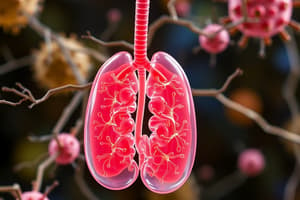Podcast
Questions and Answers
What is the primary function of aerobic respiration?
What is the primary function of aerobic respiration?
- To convert lactic acid back to glucose
- To release energy from glucose (correct)
- To increase oxygen levels in the blood
- To detect carbon dioxide in the atmosphere
Why does anaerobic respiration occur during strenuous exercise?
Why does anaerobic respiration occur during strenuous exercise?
- Because it is a more efficient process than aerobic respiration
- Because more energy is needed than can be supplied by aerobic respiration (correct)
- Because it releases more energy than aerobic respiration
- Because it is a slower process than aerobic respiration
What is the byproduct of anaerobic respiration in humans?
What is the byproduct of anaerobic respiration in humans?
- Glucose and oxygen
- Energy and carbon dioxide
- Carbon dioxide and water
- Lactic acid (correct)
Why do muscles tire quickly during anaerobic respiration?
Why do muscles tire quickly during anaerobic respiration?
What is the purpose of excess post-exercise oxygen consumption (EPOC)?
What is the purpose of excess post-exercise oxygen consumption (EPOC)?
Which of the following is NOT an example of an organ used for gas exchange?
Which of the following is NOT an example of an organ used for gas exchange?
What can be used to detect carbon dioxide?
What can be used to detect carbon dioxide?
What happens to lactic acid produced during anaerobic respiration in humans?
What happens to lactic acid produced during anaerobic respiration in humans?
Why do breathing rate and pulse rate increase during exercise?
Why do breathing rate and pulse rate increase during exercise?
What happens to the diaphragm during inhalation?
What happens to the diaphragm during inhalation?
What is the result of increased pressure outside the lungs?
What is the result of increased pressure outside the lungs?
What is the term for the movement of air into and out of the lungs?
What is the term for the movement of air into and out of the lungs?
Why is smoking harmful?
Why is smoking harmful?
What happens to the volume of the chest during inhalation?
What happens to the volume of the chest during inhalation?
Flashcards are hidden until you start studying
Study Notes
Types of Respiration
- All living cells respire to release energy for various activities.
- Aerobic respiration: glucose + oxygen → carbon dioxide + water, releasing energy.
- Carbon dioxide can be detected using limewater (turns cloudy) or an indicator (such as hydrogen carbonate) due to its acidity.
- Anaerobic respiration: glucose → lactic acid, used when energy is needed quickly (e.g., during strenuous exercise).
- Anaerobic respiration causes muscles to tire quickly and releases less energy than aerobic respiration.
Anaerobic Respiration
- Lactic acid travels from muscles to the liver, where it's converted back to glucose.
- Anaerobic respiration is not suitable for extended periods.
- After strenuous exercise, the body needs extra oxygen to replace lost oxygen stores and provide energy for aerobic respiration.
Gas Exchange
- Different organisms use various organs for gas exchange: gills (fish), skin (frogs), stomata in leaves (plants), and lungs.
Ventilation and Breathing
- During exercise, breathing rate and pulse rate increase to provide more oxygen and glucose for respiration.
- Breathing is the movement of muscles in the diaphragm and attached to the ribs, changing the chest volume.
- Breathing in (inhalation): diaphragm contracts, rib muscles contract, and lungs expand.
- Breathing out (exhalation): diaphragm relaxes, rib muscles relax, and lungs get smaller.
- Ventilation is the movement of air into and out of the lungs.
Smoking
- The chemicals in cigarette smoke are harmful.
Studying That Suits You
Use AI to generate personalized quizzes and flashcards to suit your learning preferences.




